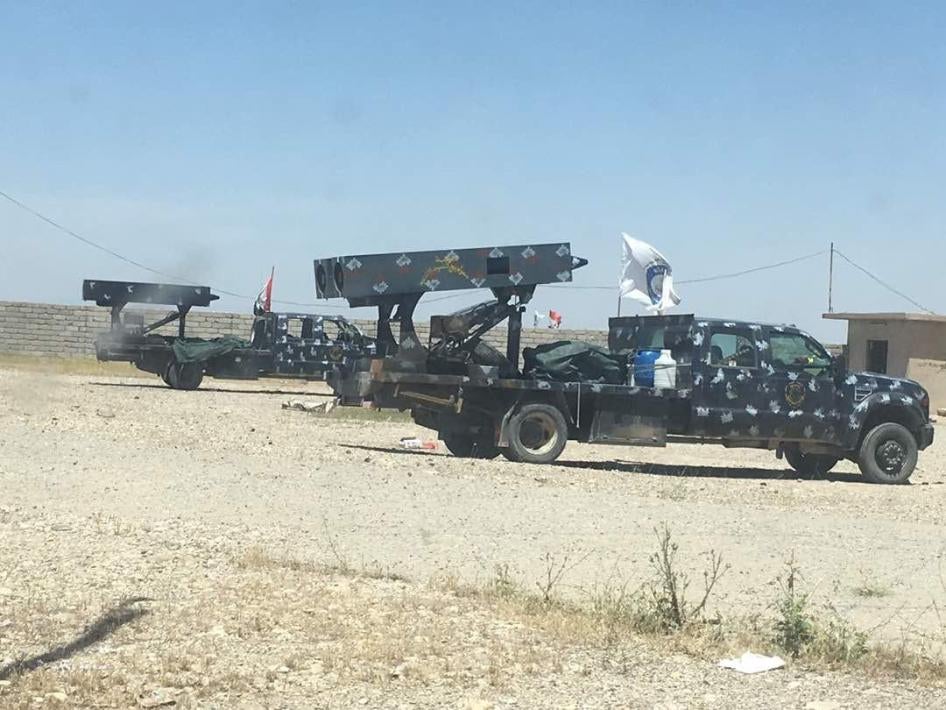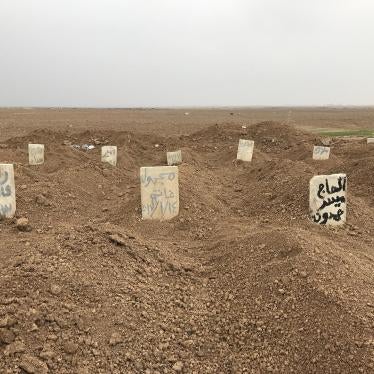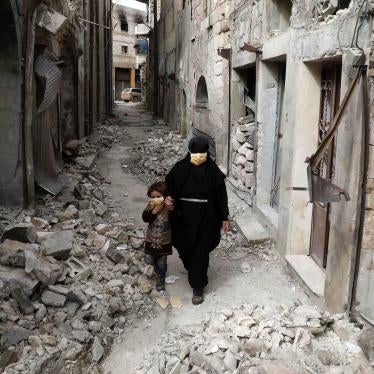(Beirut) – The expected battle involving Iraqi and US-led coalition forces against the Islamic State (ISIS) in west Mosul’s Old City poses a considerable threat to civilians and civilian objects, international humanitarian and human rights organizations said today. All warring parties should cease using explosive weapons with wide area effects and inherently indiscriminate weapons in densely populated west Mosul. ISIS’s unlawful use of civilians as “human shields” and the difficulty of identifying civilians in buildings increases the risk of civilian casualties.
The United Nations has estimated that 200,000 civilians remain in the two-square-kilometer area in west Mosul’s Old City, which Iraqi and US-led coalition forces are encircling in preparation for the battle there.
“Thousands of families are trapped by ISIS in west Mosul, with its fighters preventing civilians from fleeing to safety,” said Lama Fakih, deputy Middle East director at Human Rights Watch. “Iraqi and coalition forces should recognize that in the crowded Old City, using explosive weapons with wide area effects puts civilians at excessive risk.”
The groups expressing concern are Airwars, Amnesty International, Center for Civilians in Conflict (CIVIC), Human Rights First, Human Rights Watch, the International Network on Explosive Weapons (INEW), and War Child.
On May 25, 2017, anti-ISIS forces dropped leaflets urging civilians to immediately leave areas under ISIS control. Anti-ISIS forces should take all feasible precautions to minimize harm when carrying out attacks and ensure that civilians can safely evacuate the Old City and get humanitarian assistance both inside and outside the besieged area. With the offensive to take west Mosul entering its 109th day, the situation for civilians trapped there is growing increasingly perilous. Those fleeing Mosul have told humanitarian and human rights organizations that markets are being emptied of food, with civilians subsisting on little more than wheat and rainwater.
In mid-February, the Iraqi Security Forces (ISF) supported by the US-led coalition, known as the Combined Joint Task Force – Operation Inherent Resolve (CJTF-OIR), began the offensive to retake west Mosul, a densely populated set of urban neighborhoods.
Rising civilian casualties from aerial operations have heightened concerns regarding coalition and Iraqi forces’ use of airstrikes. The use of explosive weapons with wide-area effects such as air-dropped bombs of 500lbs and above, which have been used in the context of the operation, in densely populated civilian areas of western Mosul may be resulting in civilian casualties and damage to civilian objects that is excessive to the anticipated military objectives of the strikes. Such disproportionate military attacks are prohibited under international humanitarian law.
Iraqi forces have also been launching locally fabricated rockets, commonly known as improvised rocket-assisted munitions (IRAMs), into west Mosul. Images published by media outlets and the US military also depict US forces and Iraqi forces firing mortars and unguided artillery rockets into western Mosul. Both of these weapons are inaccurate and can be unlawfully indiscriminate if used in heavily populated areas.
The difficulty of detecting civilians in the packed city, even with advanced targeting systems and continuous observation, make it difficult to determine accurately the number of civilians occupying a target area prior to approving strikes. The dangers are increased by ISIS’s use of civilians as “human shields,” which is a war crime.
Dozens of newly displaced people from west Mosul, including the Old City, have told humanitarian and human rights organizations that ISIS fighters forced them and their families to move with them up to three times, packing large numbers of families into small neighborhoods still under their control. They witnessed fighters summarily killing dozens of men as punishment as they and their families tried to flee ISIS control. They also saw ISIS fighters fire on groups of civilians as they fled; and some saw fleeing civilians shot and killed.
As the fighting intensifies and ISIS increases its use of civilians as shields, anti-ISIS forces should use all available means to verify the presence and location of civilians in the immediate vicinity of any fighters or military objectives targeted. In December 2016, US forces made procedural changes in its targeting that may increase the likelihood of civilian casualties.
All parties to the conflict are prohibited under the laws of war from conducting deliberate attacks against civilians or civilian objects, as well as indiscriminate, or disproportionate attacks. Indiscriminate attacks are attacks that strike military objectives and civilians or civilian objects without distinction. An attack is disproportionate if it may be expected to cause incidental loss of civilian life or damage to civilian objects that would be excessive in relation to the concrete and direct military advantage anticipated from the attack.
Individuals who commit serious violations of the laws of war with criminal intent – that is, deliberately or recklessly – are responsible for war crimes. Individuals also may be held criminally liable for attempting to commit a war crime, as well as assisting in, facilitating, aiding, or abetting a war crime.
The laws of war require that the parties to a conflict take constant care during military operations to spare the civilian population and to “take all feasible precautions” to avoid or minimize the incidental loss of civilian life and damage to civilian objects. When used in populated areas, munitions with large payloads of high explosives can have a wide-area destructive effect, and it is not possible when using them to distinguish adequately between civilians and combatants, almost inevitably resulting in civilian casualties.
Weapons such as mortars and multi-barrel rocket launchers when firing unguided munitions and IRAMs are fundamentally inaccurate. This can make discriminating between civilians and combatants during an attack on a densely populated area virtually impossible. Human rights and humanitarian organizations and journalists have documented the use by Iraqi forces of IRAMs that lack the ability to be aimed beyond a basic orientation toward the target and are inherently indiscriminate.
Mortars and multi-barrel rocket launchers firing unguided munitions used by anti-ISIS forces can be aimed and adjusted by an observer, but are area-fire weapons and, when used in densely populated areas, are prone to unlawful indiscriminate use. Iraqi and US-led coalition forces should avoid all use of these weapons in the densely populated Old City of west Mosul.
Signatories:
Airwars
Amnesty International
Center for Civilians in Conflict (CIVIC)
Human Rights Watch
International Network on Explosive Weapons (INEW)
War Child
Human Rights Watch’s Investigation on Weapons Being Used and their Dangers to Civilians
Mitigation of Civilian Harm
When operating in densely populated areas where civilians and combatants are comingled, commanders should take all feasible steps to minimize the harm to civilians and civilian buildings. Where feasible, commanders should require those that maintain the ability to approve the release of weapons (terminal attack controllers) to maintain the highest level of direct control over each strike, including both seeing the target and attacking aircraft. Commanders should also limit the use of indirect-fire weapons (mortars, artillery, and rockets) using unguided munitions – meaning that the firing unit does not see the target, but relies on spotters to provide targeting information. In all cases, commanders and targeting officers should select weapons and specific munitions to minimize civilian casualties to the maximum extent possible.
Use of Airstrikes
On June 2, CJTF-OIR published its monthly civilian casualty report. The report found that: “To date, based on information available, CJTF-OIR assesses that, it is more likely than not, at least 484 civilians have been unintentionally killed by Coalition strikes since the start of Operation Inherent Resolve.” During the same period, Airwars, a UK-based nongovernmental organization that monitors airstrikes, estimated that the minimum number of civilian casualties from US-led coalition strikes was more than 3,800, approximately eight times the number reported by the coalition. Following an investigation into a March 17 strike, the US has admitted that its forces killed at least 105 civilians in just one strike when targeting two ISIS fighters. US military officials have said that non-US coalition members are responsible for at least 80 of the 484 fatalities, but none of the coalition members have publicly admitted responsibility.
Frontline medical workers have said they are seeing a higher number of traumatic injuries among civilians, including crush injuries on civilians stuck under rubble after attacks in west Mosul, than they saw in east Mosul and during previous operations in Iraq. One doctor estimated that, since the beginning of the Mosul operation in October, medical facilities have seen at least 12,000 wounded civilians, with more than 50 percent coming from west Mosul. An aid worker keeping a tally of bodies coming out of west Mosul said that, since mid-March, 650 bodies had been pulled out of the rubble of destroyed buildings in the aftermath of attacks by both sides.
Human Rights Watch analysis of satellite imagery of western Mosul identified more than 380 distinct impact sites in the Tanak neighborhood, west of the Old City, consistent with the detonation of large, airdropped munitions occurring between March 8 and April 26, 2017.
A review of damaged locations showed a majority of these airstrikes most likely targeted mixed residential and commercial buildings, with a substantial minority of strikes targeting main roads and road intersections across the neighborhood. Human Rights Watch has no information as to whether there were any military targets in or near the buildings and roads.
Although this apparently accurate targeting pattern of the road network is consistent with the use of guided munitions, Human Rights Watch found that the majority of impact craters in Tanak measured 10 or more meters in diameter, consistent with the use of conventional airdropped bombs weighing between 500 and 1,000 lbs.
Airstrikes on roads consistently resulted in impact craters impeding vehicle traffic as well as secondary damage to hundreds of residential and commercial buildings within the blast zone.
The use of explosive weapons with wide-area effects such as air-dropped bombs of this size on probable military targets in densely populated civilian areas of western Mosul may be resulting in civilian casualties and damage to civilian objects that is excessive to the anticipated military objectives of the strikes. Such disproportionate military attacks are prohibited under international humanitarian law.
Use of Improvised Rocket-Assisted Munitions
Two international observers told Human Rights Watch they had witnessed the presence of IRAM launchers as well as IRAMs being fired on numerous occasions from May 5 to 14. They saw Federal Police-marked and Emergency Division-marked launchers mounted on wheeled vehicles in areas northwest of west Mosul, and in a western and southern neighborhood of west Mosul. In the village of Badoush, 10 kilometers northwest of the city, one observed IRAMs and IRAM launchers at an Emergency Response Division military workshop.
Three other observers and at least one media outlet confirmed that the munitions were being fired. One observer said the Emergency Response Division fired multiple munitions from Haramat neighborhood west of the Old City in the direction of the Old City in early May, while another said he saw the Federal Police fire at least 13 IRAMs from a neighborhood just south of the Old City into the Old City over two days in mid-April. They said that the armed forces would not allow any photos of the munitions being fired. The third said that in mid-May he saw the Emergency Response Division fire at least six into the Old City from Badoush.
Two observers who were able to examine the munitions closely said they saw a small metal barrel containing an unknown type of propelling charge, attached to the sawn-off nose of a 105mm artillery projectile, equipped with a fuze. The warhead was welded to a shaft, which included a rocket. Small homemade fins were bolted and welded to the shaft near its base. The launching pods were elevated using a hydraulic system from the rear deck of the wheeled vehicles. One observed that the rockets did not fit snuggly into the launcher tubes, which could lead to an uneven distribution of the rocket motor’s blast when initiated, leading to an unstable launch and subsequent deviation of the trajectory. The observers said that there was no visible sighting or laying system on the vehicles or launching pods, which would allow the position of the weapon to be shifted to hit a specific target, making even attempting to aim the rockets with any accuracy impossible.
Use of Mortars
Recent photos and a video posted by the US military and Reuters depicting the firing of mortars outside Mosul raise concerns about the firing of unguided and inaccurate weapons into the densely populated Old City. The photos, posted to a US military web account, are dated March 18 and 19. They depict the use of three different mortar systems: the M224, which fires a 60-milimeter projectile; the M252, which fires an 81-milimeter projectile; and the M120, which fires a 120-milimeter projectile. In the photos, the projectiles used appear to be standard high-explosive rounds.
In the video posted by the US Military on May 19, both the M252 and M120 mortars are observed. In the photos and video available, the projectiles used appear to be standard high-explosive rounds. Photos posted by Reuters on May 27 show Iraqi Emergency Response Division forces loading and firing an Al-Jaleel 82mm mortar system on the outskirts of Mosul. A larger system, the Al-Jaleel 120mm mortar, appears off to the side. None of the projectiles for the mortars depicted in either the photos or video were guidance munitions.
Mortar systems using unguided projectiles are fundamentally inaccurate weapons and can only hit the area near an identified target. As such, the location each round strikes cannot be determined with a high degree of accuracy before its use. Rounds are fired by mortar teams and a “spotter” is used to observe each impact and recommend adjustments in aim to the crew to adjust the fire and eventually achieve desired effects on the intended target, be it suppression, incapacitation, or destruction. The first round fired after a mortar tube and baseplate are set-up is called a registering round, which allows the weapon to settle and for the spotter to see how accurate the initial calculation was.
If the initial round does not strike the target, additional rounds will be fired and their impacts observed until the right calculation is made. Common methods for ensuring the round strikes the intended target include “walking” the round onto the target or “bracketing.” The former method involves firing one round and then making incremental lateral or vertical adjustments to the weapon until the round strikes the target. The latter method involves making broader lateral or vertical adjustments so that the round strikes either side of the target until an accurate calculation can be made and the target is hit.
Use of Multi-Barrel Rocket Launchers
Recent photos published by Reuters depict Iraqi Popular Mobilization Forces, also known as Hashd al-Sha’abi, utilizing a variant of the BM-21 Grad multi-barrel rocket launcher on the outskirts of Mosul. Use of this weapon compounds concerns about the use of area-fire explosive weapons in the densely populated Old City. Grad systems fire 122-milimeter artillery rockets launched from up to 40 launch tubes. Most Grad rockets have a range of 1.5 to 20 kilometers. The rockets vary in length from 1.9 to 3.3 meters and weigh 45 to 75 kilograms. Most types of Grad rockets are unguided and can only be targeted on an area, and are often fired in salvos by their launchers to rapidly saturate an area.
Grad rockets can be equipped with various types of warheads. The most common is a high explosive/fragmentation type, which contains approximately 6.4 kilograms of high explosive and is designed to produce 3,150 fragments, which can kill or injure within a radius of 28 meters from its impact point. At its maximum range of some 20 kilometers, the most common rocket (9M22U) with the basic high explosive/fragmentation (M-21-OF) warhead is only accurate within a rectangle of 336 meters by 160 meters. In other words, from its aim point, the rocket could land anywhere within a rectangle of approximately 54,000 square meters.









